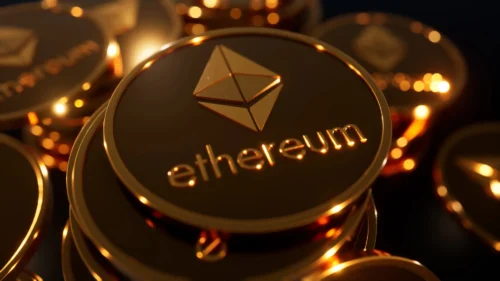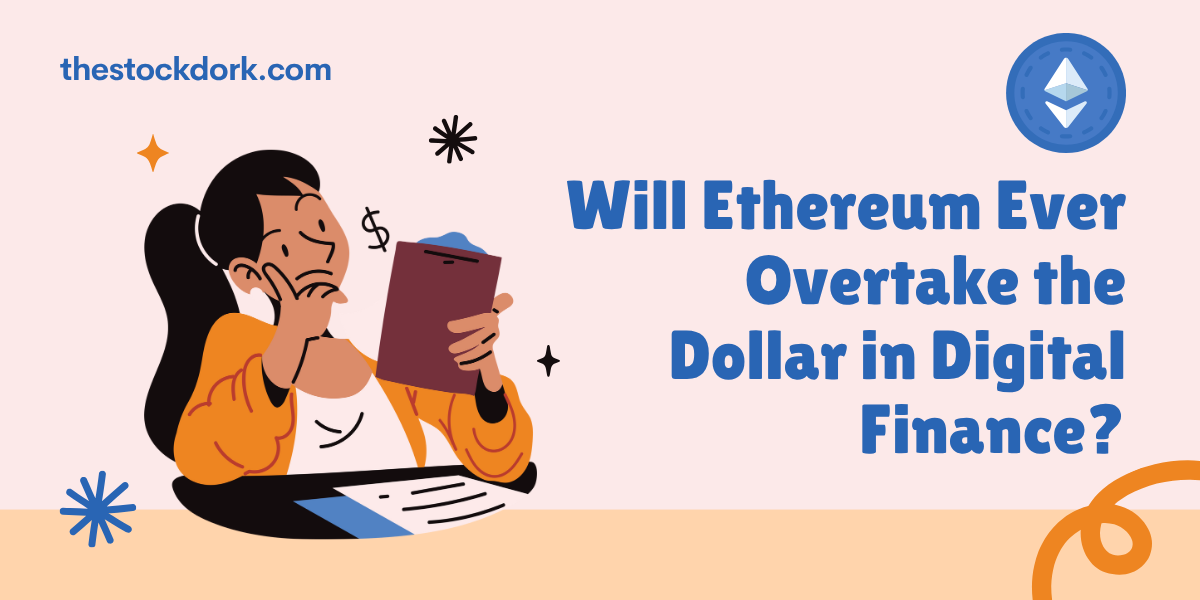The U.S. dollar has ruled global finance for almost a century. It anchors international trade, powers foreign reserves, and acts as the main medium of exchange worldwide. But times are changing.
Ethereum, the second-largest cryptocurrency, has grown into more than just digital money. It is a global network where finance is being rebuilt from the ground up.

To answer this, we need to look at what makes the dollar strong, how Ethereum is different, and where both may fit in the future.
Ethereum and the U.S. Dollar: Setting the Context
A Brief History of the Dollar’s Role
The U.S. dollar became the world’s dominant currency after World War II. The Bretton Woods Agreement in 1944 pegged global currencies to the dollar, which was tied to gold. Even after the U.S. left the gold standard in 1971, the dollar held its place.
Today, the dollar makes up about 58% of global foreign exchange reserves according to the IMF. Over 80% of international trade is priced in dollars. Oil, gold, and even many consumer goods rely on it. It is stable, liquid, and backed by the most powerful government in the world.
When investors compare ethereum to usd, they see two very different types of money. The dollar offers stability and long-term trust.
Ethereum, on the other hand, brings decentralization, programmability, and innovation in digital finance. This contrast sets the stage for the debate over whether Ethereum could ever overtake the dollar’s role.
Ethereum’s Rise in Digital Finance
Ethereum launched in 2015. Unlike Bitcoin, it was not built just to transfer money. It introduced the concept of smart contracts, programs that run on the blockchain. This opened the door to decentralized finance (DeFi), decentralized apps, and tokenized assets.
Today, Ethereum processes more value than most traditional payment networks. According to YCharts, it settles over $20 billion daily in transactions.
It is the backbone of DeFi, stablecoins, NFTs, and even experiments with digital identities. Ethereum has become more than a cryptocurrency, it is an entire financial system.
Strengths of Ethereum Compared to the Dollar
Decentralization and Trustless Transactions
The dollar depends on banks, governments, and intermediaries. Ethereum runs on a decentralized network of nodes across the globe. No single authority can freeze or block transactions. That makes it censorship-resistant and open to anyone with an internet connection.
This matters in countries with capital controls or unstable banking systems. In places like Argentina or Nigeria, citizens often turn to crypto when access to dollars is restricted. Ethereum offers a lifeline when the dollar itself becomes hard to reach.
Smart Contracts and Programmability
The dollar is money, but Ethereum is money with built-in code. Smart contracts allow automated financial services—loans, insurance, trading—all without banks. For example, protocols like Aave and Uniswap run on Ethereum, handling billions in volume without a central authority.
This innovation gives Ethereum a key advantage. The dollar cannot execute a contract on its own. Ethereum can handle agreements, settlements, and assets in one place.
Global Accessibility
Billions of people are unbanked or underbanked. Opening a U.S. dollar account often requires paperwork, identity checks, and trusted banks. Ethereum needs none of this. Anyone with a smartphone can join.
Cross-border transfers highlight the gap. Sending dollars abroad can take days and cost high fees through banks. Ethereum transfers often settle in minutes at a fraction of the cost, especially on Layer-2 networks.
Deflationary Tendencies After EIP-1559 and Proof of Stake
In 2021, Ethereum introduced EIP-1559, which burns part of every transaction fee. Combined with Proof of Stake, this has at times made Ethereum deflationary. The total supply of ETH has even shrunk during high network activity.

Barriers to Ethereum Overtaking the Dollar
Volatility
Ethereum remains volatile. In 2021 it traded above $4,800, but by mid-2022 it fell below $1,000. Such swings make it unsuitable as a daily currency for salaries or rent. The dollar, while not perfect, offers stability. Even during crises, it remains a safe haven.
Scalability Challenges
Ethereum’s network has faced congestion. During peak demand, gas fees can rise to $50 or more per transaction. Upgrades like Ethereum 2.0 and Layer-2 scaling help, but adoption at the scale of billions of users is still a challenge.
Visa processes about 65,000 transactions per second. Ethereum handles around 30 at the base layer. Even with rollups and scaling, it has a long way to go.
Regulatory Uncertainty
Ethereum is not fully embraced by regulators. The U.S. SEC has debated whether ETH is a security. Governments also fear its use in illicit finance. While the dollar enjoys clear legal standing, Ethereum’s regulatory future remains murky.
Adoption Gap
Merchants and institutions rely on the dollar. Payrolls, trade deals, and taxes are dollar-based. Ethereum adoption is growing, but it is still a niche. Until businesses widely accept it, overtaking the dollar remains unlikely.
The Middle Ground: Ethereum Complementing, Not Replacing, the Dollar
Stablecoins as the Bridge
Stablecoins like USDC and USDT are built on Ethereum. They combine the stability of the dollar with the efficiency of blockchain. In 2025, stablecoins process more than $3 trillion annually, rivaling some payment networks.
This shows Ethereum may not replace the dollar, but it provides the rails for digital dollars to move faster and cheaper.
Tokenization of Assets
Ethereum enables tokenization—turning real-world assets into blockchain tokens. Bonds, real estate, and even treasuries are moving on-chain. These assets are still priced in dollars, but Ethereum provides the infrastructure.
This means Ethereum strengthens the dollar’s role in digital finance rather than replacing it.
CBDCs (Central Bank Digital Currencies)
The U.S. is exploring a digital dollar. Some pilots even test Ethereum-based infrastructure. If the government launches a CBDC, Ethereum could be part of the tech stack. This makes it less of a competitor and more of a partner to the dollar.
Expert Predictions and Scenarios
Scenario 1: Ethereum Becomes Digital Gold
Some experts believe Ethereum will not replace the dollar but serve as “digital gold.” Like gold, it could act as a store of value. Its scarcity mechanisms and network demand support this role. Investors may treat ETH as a hedge against dollar inflation.
A recent commentary from Binance highlighted that Ethereum’s role in DeFi and tokenized assets positions it as a parallel financial system, not a replacement for the U.S. dollar.
This reflects a growing view that the future may involve coexistence rather than a full takeover.
Scenario 2: Parallel Financial Systems
A likely outcome is that Ethereum and the dollar co-exist. Fiat finance will remain dominant in trade and reserves. Ethereum will dominate in decentralized apps, cross-border settlements, and Web3 innovation. Both systems may grow side by side.
Scenario 3: Ethereum Surpasses USD in Specific Niches
Ethereum may never replace the dollar globally, but it could surpass it in niches. In DeFi, Ethereum already leads. In countries with weak currencies, people may choose Ethereum over dollars for payments. Emerging markets could see Ethereum adoption rise faster than dollar banking.
The Role of Payment Networks and Fiat Gateways
A key question is how Ethereum meets the real economy. Today, exchanges and payment processors make it possible to move between ETH and dollars.
One area where Ethereum is growing is in Visa and Mastercard deposits. Many crypto exchanges allow users to buy ETH instantly with cards and withdraw in USD. This tightens the link between Ethereum and the dollar.
As more payment networks integrate Ethereum, the barrier between traditional finance and crypto lowers. This does not replace the dollar, but it does increase Ethereum’s role as part of the same system.
Conclusion
Ethereum has reshaped digital finance in less than a decade. It brings decentralization, programmability, and global reach. The dollar remains the backbone of the financial system, with unmatched stability and trust.
Ethereum may not overtake the dollar as the world’s main currency anytime soon. But it is already carving out new territory. Through DeFi, stablecoins, and tokenization, Ethereum is pushing the boundaries of what money can do.
The future may not be a battle between ETH and USD. Instead, it could be a blend of both, Ethereum powering innovation, and the dollar providing stability. Together, they could define the next era of digital finance.
FAQs
Can Ethereum replace the U.S. dollar as the world’s reserve currency?
It is unlikely in the near future due to volatility and regulation.
Why is Ethereum considered more innovative than the dollar?
Ethereum enables smart contracts and decentralized applications, which the dollar cannot.
How do stablecoins impact Ethereum’s role vs. the dollar?
Stablecoins combine dollar stability with Ethereum’s blockchain features, making ETH infrastructure essential.
Is Ethereum a better store of value than the dollar?
Ethereum has deflationary tendencies, but its price volatility limits it as a daily store of value.
Could Ethereum power the future digital dollar?
Yes, the U.S. may use Ethereum-based systems to build a CBDC, making ETH a partner in digital dollar finance.


 Tags:
Tags:










